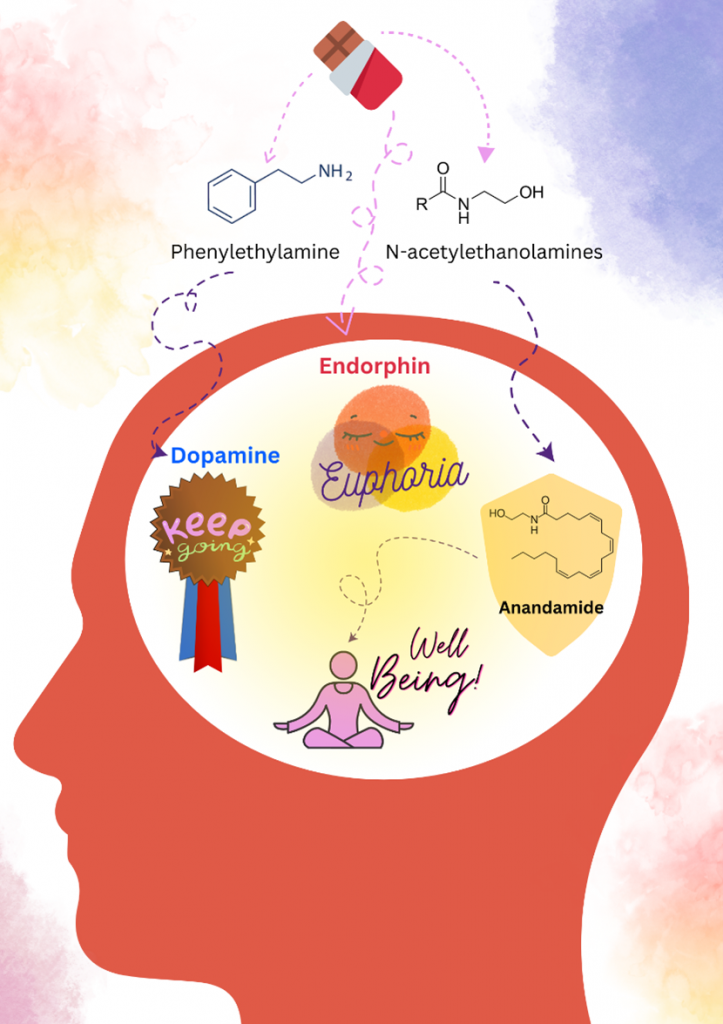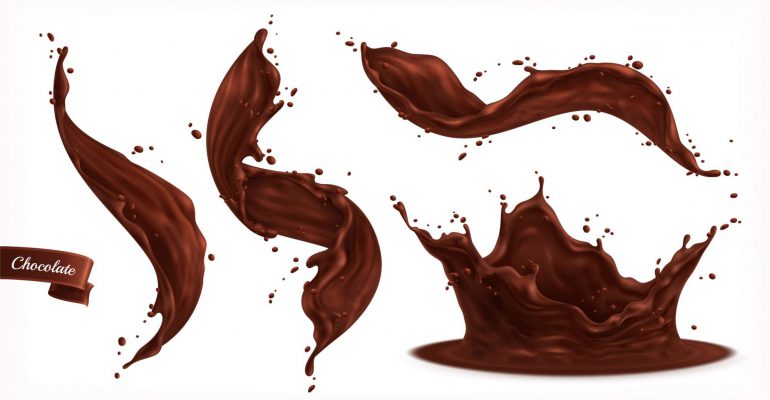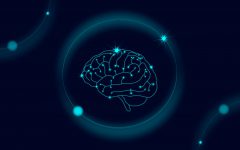Like eating chocolates? Here’s the reason!
April 20, 2023 2023-04-25 6:10Like eating chocolates? Here’s the reason!
Imagine you are cozily lying on a bed with your favorite book in one hand while soothing music is playing in the background. Just as you bite into the last piece of chocolate, a sudden thought crosses your mind, ‘I want more of it, but why?’
In order to save you from getting out of bed and looking for the solution yourself, I will answer. Besides the sweet taste and aroma of the chocolate, it is the texture and the fat content that keeps you hooked up.
According to a study1, chocolate belongs to the phase change material (PCM) category, meaning it has the power to transform from a solid state to a molten state while drenching your mouth in flavors. It interacts with your palette in three stages. A layer of fat (cocoa butter) covers your palette at the licking stage, preventing watery saliva from wiping the chocolaty taste off your tongue. Chocolate melts as you masticate, and the continuous fat layer surrounding the coarse cocoa particles serves as a barrier to prevent the particles from making direct contact with your tongue and disrupting your mouth feel. As saliva mixes with chocolate, aggregates of cocoa and fat emerge, giving the chocolate a gritty feel before you finally swallow it.
I now have my doubts about Motecuhzoma, the ninth monarch of Tenochtitlan (now in southwest United States), who consumed the “Elixir of God” (a spicy chocolate drink) 50 times every day2. What was the texture that made him enjoy drinking chocolate so frequently?

But it is not just the texture of chocolate that makes you swoon over it. Something called the ‘chocolate sensation’3 triggers the mood centres of your brain. It includes certain psychoactive compounds like phenylethylamine4 that stimulate dopamine release5. Dopamine has links to the brain’s reward system, which prompts a person to keep eating chocolate in order to receive rewards.
N-acetyl ethanolamine is another such chocolate constituent4 that hits your brain. It prevents the breakdown of what is called the ‘bliss molecule.’ Chemically named anandamide, it binds to cannabinoid receptors, resulting in heightened happiness and a sense of well-being, characteristics synonymous with the Sanskrit word ‘ananda’ from which it lends its name6.
Endorphins also form part of the chocolate sensation7 sending a person to the world of euphoria8. Although some websites claim that chocolate also enhances the production of oxytocin and serotonin, I could not find any supporting scientific data for this claim (though one study9 hints that it does). Even a chocolate bar contains enough protein to limit the rise in tryptophan and serotonin due to its high carbohydrate content4.
One would wonder if chocolate is a drug in light of these pleasurable and uplifting chemicals in their favourite chocolate bar and cup of hot cocoa. However, FDA comes to the rescue and says it to be not as these substances are present in incredibly minute quantities10.
Whatsoever the case, no one can deny Roach’s observation4 that ‘Caviar is exquisite, but people don’t declare their love with ten-pound heart-shaped boxes of it…No one makes 3:00 AM runs to the 7-Eleven for butterscotch. But chocolate…chocolate inspires a passion normally reserved for things grander than food.’
Authored by Sakshi Hardaha, BITS Biocon Certificate Program in Applied Industrial Microbiology, Batch 9
References-
1. Soltanahmadi S, Bryant M, Sarkar A. Insights into the Multiscale Lubrication Mechanism of Edible Phase Change Materials. ACS Appl Mater Interfaces. 2022;15:3712. doi:10.1021/ACSAMI.2C13017/ASSET/IMAGES/LARGE/AM2C13017_0008.JPEG
2. Maciej Serda, Becker FG, Cleary M, et al. Synteza i aktywność biologiczna nowych analogów tiosemikarbazonowych chelatorów żelaza. G. Balint, Antala B, Carty C, Mabieme JMA, Amar IB, Kaplanova A, eds. Uniwersytet śląski. 2013;7(1):343-354. doi:10.2/JQUERY.MIN.JS https://www.chocolate.org/blogs/chocolate-blog/chocolate-and-the-aztecs
3. Carolina Villagra. Researchers in UK university find out why chocolate tastes so good. January 31, 2023; https://wsvn.com/news/us-world/researchers-in-uk-university-find-out-why-chocolate-tastes-so-good/
4. Bruinsma, K., & Taren, D. L. Chocolate. Journal of the American Dietetic Association. 99(10). 1999; doi:10.1016/ s0002‐8223(99)00307‐7
5. S.R. Philips. Invivo release of endogenous dopamine from rat caudate nucleus by β-phenylethylamine and α,α,-dideutero-β-phenylethylamine. 1986; doi:10.1016/0024-3205(86)90480-7
6. Deane Alban. Anandamide: Putting The Bliss Molecule To Work For Your Brain – Reset.me. Accessed March 4, 2023. https://reset.me/story/anandamide-putting-the-bliss-molecule-to-work-for-your-brain/
7. de Feo M, Paladini A, Ferri C, et al. Anti-Inflammatory and Anti-Nociceptive Effects of Cocoa: A Review on Future Perspectives in Treatment of Pain. Pain Ther. 2020;9(1):231. doi:10.1007/S40122-020-00165-5
8. Chaudhry SR, Gossman W. Biochemistry, Endorphin. In: StatPearls. Treasure Island (FL): StatPearls Publishing; 2022 Jan-. Available from: https://www.ncbi.nlm.nih.gov/books/NBK470306/
9. de Boer A, van Buel EM, ter Horst GJ. Love is more than just a kiss: A neurobiological perspective on love and affection. Neuroscience. 2012;201:114-124. doi:10.1016/j.neuroscience.2011.11.017
10. Dillon Wallace. Guess what chocolate does to your mind…-Southtree. Accessed March 4, 2023. https://southtree.com/blogs/artifact/guess-what-chocolate-does-to-your-mind







